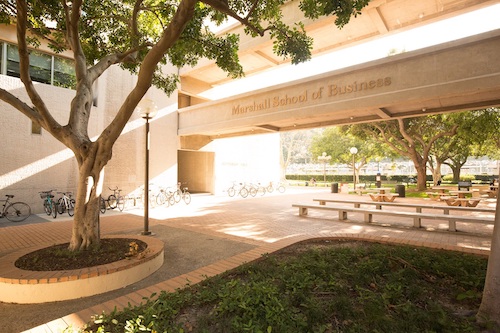 As faculty and staff prepare for a return to campus in August, there are many unknowns. The only thing certain is that Fall 2021 won’t look like Fall 2019.
As faculty and staff prepare for a return to campus in August, there are many unknowns. The only thing certain is that Fall 2021 won’t look like Fall 2019.
That isn’t stopping the massive effort being made behind the scenes. While every program office has a long to-do list of necessary tasks, three areas were priorities: Preparing classrooms for potential hybrid teaching, upgrading technology in those classrooms as well as in employee offices, and training faculty to use and optimize new classroom technology.
Marshall Facilities, IT, and the Teaching & Innovation team did much of the heavy lifting over the spring and summer months.
“We all worked together,” said Director of Facilities Jane Hamatani. "And we actually became closer as a school for doing it.”
Those Who Stayed
When the COVID-19 shut down campus abruptly in March 2020, nobody, not even USC leadership, could have guessed that the closure would last nearly a year and a half. Students left dorms, and staff and faculty left their offices for what they thought would be a week-long remote trial only to have that timeframe extend by a few weeks … and then indefinitely.
Some workers never left. At Marshall, the Facilities team had to power down and secure each of Marshall’s five buildings. Air conditioners were turned off and lights dimmed. Security still made the rounds, and the custodial team worked on a truncated schedule.
When some activity returned to campus, Facilities used contact tracing to keep track of everyone entering a building and sent lists of areas that needed sanitizing afterward to the custodial team. There were mishaps. Food left in refrigerators needed removing. Months into the lockdown, neglected cases of soda stored in offices began exploding, causing damage to carpets and walls.
“Our vendors, Aramark and Allied, were our eyes and ears over the course of the lockdown,” said Ana Téllez McKey, facilities coordinator.
The Facilities team was central in assisting other teams with critical tasks, from logistically identifying which faculty needed new key cards to providing access to offices and classrooms being fitted with new and upgraded technology.
New Technology Everywhere
The pandemic accelerated changes that were already happening. Nowhere is that more true than in technology-enhanced learning.
In the service of accessibility, when students return to the classroom they will find cameras and screens to enhance hybrid learning. Two monitors have been installed in every classroom so that any students who must remain remote (for approved medical reasons or international travel restrictions) can participate in class. The faculty member will be able to see his or her Zoom students and project their faces onto another screen so those students can interact with the students in the classroom. The faculty member can also project their teaching decks onto another screen so everyone can see. Upgrades in audio mean every student can hear no matter where they are. There are even movement-tracking cameras being installed so that everyone can follow the professor’s movements around the class.
“The technology we have is amazing,” said Patricia Mills, Vice Dean for Teaching & Innovation. “IT has scheduled faculty trainings that have been ongoing throughout the summer. My team helped in the early stages to find out what the faculty wanted to be able to do in the classroom. Then IT came in and made that happen.”
Some of the training goes beyond the technical and into the pedagogical: For example, how do you teach effectively to two groups of students—one present and one via Zoom? How do you write a syllabus that reflects hybrid participation expectations? That’s where the Teaching & Innovation team come in.
“Marshall IT knew that supporting the community in its return to campus would be harder than the exodus,” said Marshall Chief Information Officer Cathy Bindewald. But even they didn’t anticipate the complexity a mass return would require.
“My team started planning the return effort almost as soon as the remote work began, and this team has certainly risen to the challenge in an extraordinary way,” she said. “In this planning, we have deepened numerous Marshall relationships, especially with our facilities partners.”
Much of her team has been back on campus since April, she said, helping upgrade classroom technology, leading classroom training, assisting with office moves and preparing workspaces. IT has worked tirelessly to turn the technology back on so that systems get updated and patched, among many other tasks.
Janet Horan, Marshall’s new CFO came aboard (remotely) in Jan. 2021 but has been coming to campus since April.
“The last 17 months have helped us become more agile in the way we work together, and the way we deliver education,” she said. “And I know we will retain some of the lessons we’ve learned along the way.”